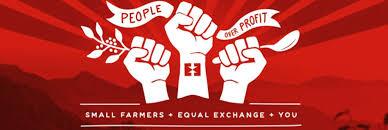Did you know there are more than 2,000 fair trade producer organizations in more than 70 countries ? Tens of thousands of fair trade products are on the market, including coffee, tea, chocolate, flowers, fruit, vegetables, grains, apparel, artisan handcrafts, and more. Fair trade began with the sale of handcrafts and other artisan goods in the 1940s. The first fair trade coffee company in the US, Equal Exchange (a worker-owned cooperative) was launched in Boston in 1986. IRTF brought their coffee to Cleveland, made it available to faith congregations and grocers. Quickly, NE Ohio became one of the top markets for fair trade coffee in the country. Learn more about fair trade and see the schedule of upcoming fair trade sales, including the annual Ohio Fair Trade Teach-In & Expo, at www.OhioFairTrade.com.
- Home
- About Us
- Issues
- Countries
- Rapid Response Network
- Young Adults
- Get Involved
- Calendar
- Donate
- Blog




